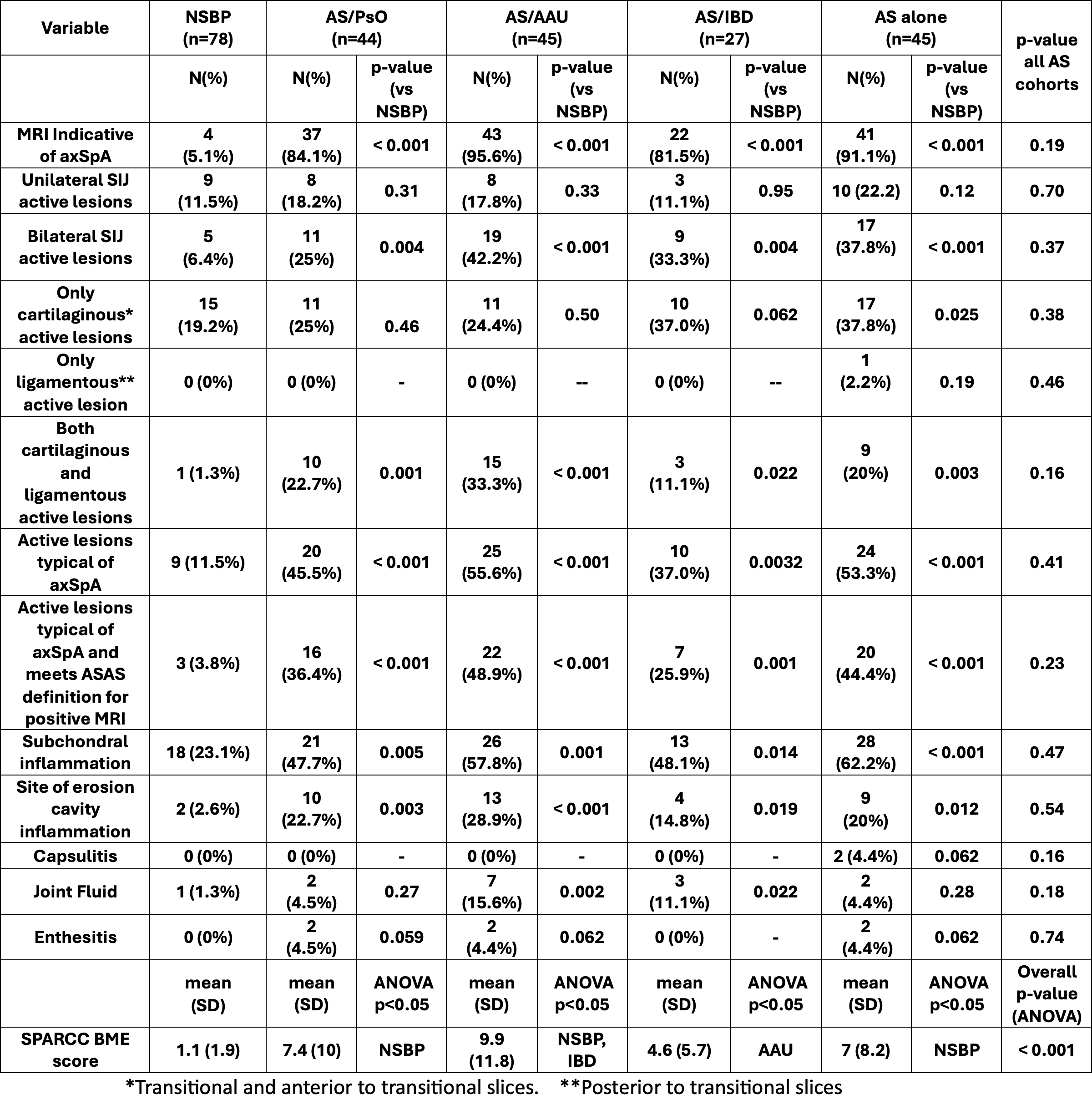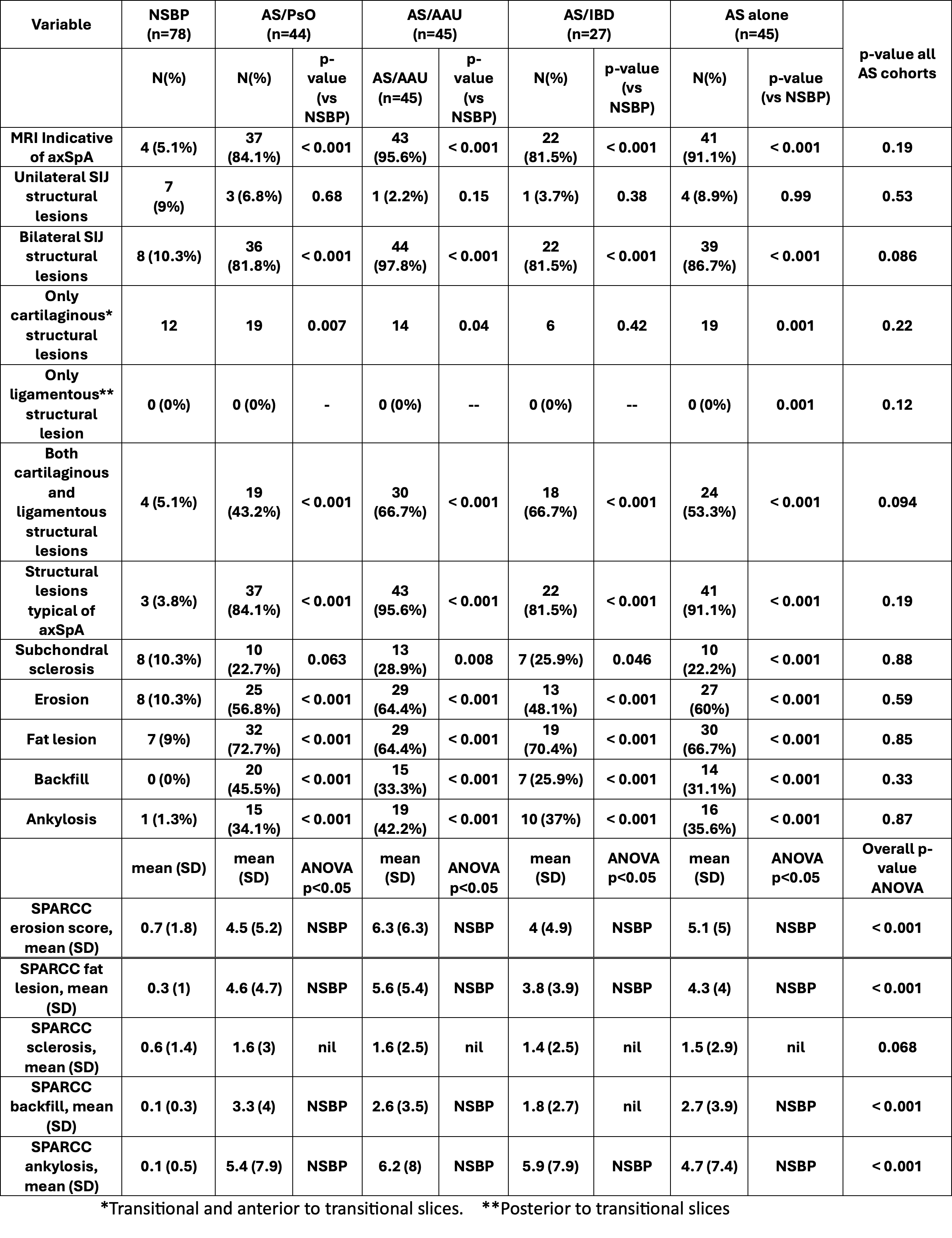Session Information
Date: Sunday, November 17, 2024
Title: SpA Including PsA – Diagnosis, Manifestations, & Outcomes Poster II
Session Type: Poster Session B
Session Time: 10:30AM-12:30PM
Background/Purpose: There is limited information on the frequency and topographical distribution of MRI lesions in the sacroiliac joints (SIJ) of patients with axSpA according to different clinical phenotypes encompassing patients with concomitant psoriasis (PsO), acute anterior uveitis (AAU), and inflammatory bowel disease (IBD). This is relevant to diagnosis, and it has been suggested that those with psoriasis may have more unilateral disease and features indicative of enthesitis. We aimed to apply the recently standardized ASAS definitions of MRI SIJ lesions1 to determine whether there are differences in MRI features in the SIJ according to clinical phenotype of axSpA and when compared to matched controls with back pain that was not due to axSpA (non-axSpA).
Methods: Patients diagnosed with axial spondyloarthritis (axSpA) and fulfilling the modified New York criteria (mNY) were included from a prospective, observational cohort (ALBERTA FORCAST). All axSpA patients with AAU, PsO, or IBD, diagnosed by an ophthalmologist, dermatologist, or gastroenterologist, and with available MRI SIJ scans (semicoronal T1W, STIR) were matched for age and gender with scans from axSpA cases without extra-articular features (axSpA-alone) and scans from non-axSpA controls with mechanical back pain. MRI active and structural lesions per ASAS definitions were evaluated by 3 readers blinded to clinical details and recorded in the ASAS MRImagine-consensus based eCRF that comprised global assessment (MRI indicative of axSpA, active or structural lesion typical of axSpA present/absent) and detailed scoring of lesions per SIJ quadrant or halves (SPARCC method). We conducted pairwise comparisons of lesion distribution and frequencies for each individual axSpA subgroup versus non-axSpA controls and analysis by ANOVA across all axSpA subgroups.
Results: Scans were available from 44, 45, 27, 45, axSpA patients with PsO, AAU, IBD, or axSpA-alone, respectively, and 78 matched non-axSpA controls with mechanical back pain. Unilateral and bilateral SIJ distribution of lesions were similar among subgroups, lesions were predominantly located in the cartilaginous compartment, and only one patient (axSpA-alone) had an MRI lesion confined to the ligamentous compartment. There was no predilection of a particular inflammatory or structural lesion type for any one of the axSpA subgroups (Tables 1 and 2). Structural lesions typical of axSpA had greater sensitivity and specificity for all subgroups. Among highly specific ( >95%) inflammatory lesions, inflammation in an erosion cavity or enthesitis or capsulitis or joint fluid, were not observed in the absence of BME except for 3 cases with axSpA. Among highly specific structural lesions, backfill was only observed in cases with axSpA.
Conclusion: The clinical phenotype of axSpA per extra-articular features is not associated with significant differences in the distribution or frequencies of MRI lesions in the SIJ. Certain active and structural lesions have equally high diagnostic utility among all axSpA subgroups.
1.
< ![if !supportLists] >1. < ![endif] >Maksymowych et al. Ann Rheum Dis 2019;78:1550-1558
To cite this abstract in AMA style:
Weber U, Pedersen S, Bayindir Tsechelidis O, Lambert R, Paschke J, Wichuk S, Maksymowych W. Systematic Characterization of MRI Lesions Per ASAS Definitions in the Sacroiliac Joints of Patients with Axial Spondyloarthritis and Comparisons Among Subgroups with Psoriasis, Iritis, Colitis, AxSpA Alone, and Matched Back Pain Controls [abstract]. Arthritis Rheumatol. 2024; 76 (suppl 9). https://acrabstracts.org/abstract/systematic-characterization-of-mri-lesions-per-asas-definitions-in-the-sacroiliac-joints-of-patients-with-axial-spondyloarthritis-and-comparisons-among-subgroups-with-psoriasis-iritis-colitis-axspa/. Accessed .« Back to ACR Convergence 2024
ACR Meeting Abstracts - https://acrabstracts.org/abstract/systematic-characterization-of-mri-lesions-per-asas-definitions-in-the-sacroiliac-joints-of-patients-with-axial-spondyloarthritis-and-comparisons-among-subgroups-with-psoriasis-iritis-colitis-axspa/


